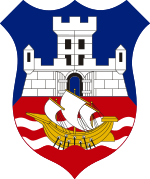Coat of arms of Belgrade
| Coat of arms of Belgrade | |
|---|---|
 |
|
| Versions | |

Greater coat of arms
|
|
| Details | |
| Armiger | City of Belgrade |
| Adopted | 1931 |
| Orders |
Karađorđe's Star (1939) Légion d'honneur (1920) Czechoslovak War Cross (1925) People's Hero (1974) |
The coat of arms of Belgrade was designed by painter Đorđe Andrejević-Kun and adopted in 1931.
The original coat of arms was commissioned in 1931 by Belgrade mayor Milan Nešić. The winning proposal was sketched by Đorđe Andrejević-Kun. The arms remained in continued use until the conclusion of the Second World War. The use of the arms was amended and regulated in 2003.
The arms contain the Serbian national colours (red, blue, and white). The red ground symbolises blood split over the city during its many conflicts. The blue sky symbolizes hope and faith in a better future. The white walls and tower symbolise the "white city" (Belgrade – Beograd literally means "the white city). The white rivers below represent the Danube and Sava and the primordial beginning of Belgrade while the Roman trireme refers to its antiquity. The open gates of the city represent free communication and commerce with the world.
The small (or lesser) coat of arms is the original design by Đorđe Andrejević-Kun. It features a simple escutcheon.
The middle (or medium) coat of arms is identical to the small, but with the addition of a golden mural crown placed above the escutcheon. The crown features five merlons, and a diadem with five gems (rubies, sapphires, emeralds). According to the standards of Serbian Heraldry Society, this wall crown with five indents belongs only to the capital city, and the diadem with jewels belongs to the historical capitals.
The greater coat of arms consists of a silver (white) bicephalic eagle, with gold talons and beak. The eagle is a symbol of the Serbian state, and is consistent with the national coat of arms of Serbia. On the eagle's chest are the coat of arms of Belgrade, which emphasis the status of capital, and above the eagle's heads is the wall crown of the medium coat of arms. Underneath the eagle are two oak branches, which represent civic virtues, and over the point where they cross is the first known coat of arms of Belgrade, which represents the heraldic history of the city. The sword and the olive branch on the large coat of arms represent readiness to fight in war, and to cooperate in peace. Over the oak branches are decorations given to Belgrade, in their natural colours, and with appropriate ribbons. They stand for the glorious past and merits of the citizens of Belgrade. The medals are:
...
Wikipedia
